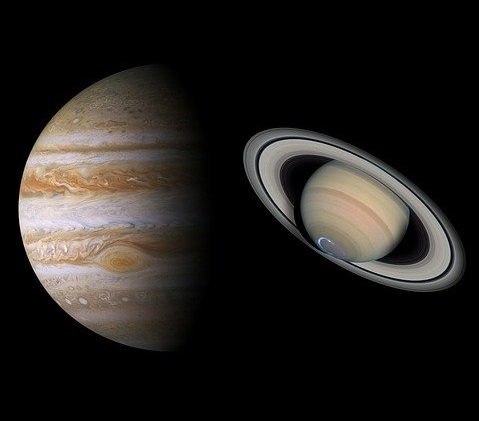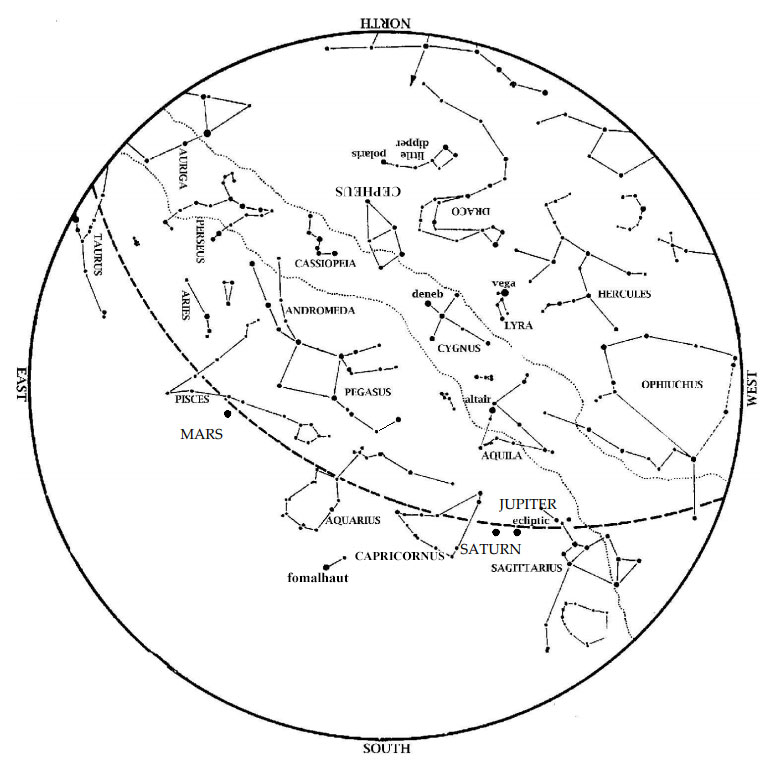Jupiter and Saturn are in the southwest at dusk this month. Look south-southwest in the early evening for the two planets which will be about 5 degrees apart. You’ll see Jupiter noticeably closer to Saturn each week; they are just over 2 degrees apart by November 30. (Saturn is moving too, but even more slowly than Jupiter). By December 21, the two planets will be only six arcminutes (one tenth of one degree) apart in the sky. Jupiter outshines every star up at night.

Mars was up all night long last month. This is because on October 13, Earth overtook Mars on its inner, faster orbit. Mars now fades a little bit each night now that Earth has overtaken it and is pulling away. However, it fades out gradually; Mars remains brighter than all the stars we see at night through November 20, and is among the brightest things you’ll see in the sky for the rest of 2020. And Mars is well placed for observing right as night falls.
Venus is now visible in the east at dawn. It remains a ‘morning star’ for the rest of 2020.
Constellations in the November southern sky are almost entirely devoid of bright stars. They represent beasts and gods related to water, indicating that they are part of the ‘Celestial Sea’. Examples are Aquarius, the Water Bearer and Pisces, the Fish. Even Capricornus, the Goat, has a fish tail because he’s originally Ea, Babylonian god of the waters. Below Aquarius is the one bright star in this area, Fomalhaut, marking the mouth of the Southern Fish. Ancient Mesopotamians imagined that the Persian Gulf extended upwards into the sky, joining this ‘sea’ of dim stars.
More recognizable are the Great Square of Pegasus high and almost overhead and the Summer Triangle, still visible in the west. Orion rises by 9:30 pm tonight and by 7:30 pm by the 30th.
Moon Phases in November 2020:
Last Quarter Nov. 8, 7:46 a.m.
New Nov. 14, 11:07 p.m.
1st Quarter Nov. 21, 10:45 p.m.
Full Nov. 30, 3:30 a.m.

The Summer Triangle is high in the west. The ‘teapot’ of Sagittarius sets in the southwest. Jupiter approaches Saturn in Sagittarius in the southwest at dusk. Mars, although past opposition, remains brilliant in the east. The Great Square of Pegasus is high in the east at dusk. To the south and east, we see a vast dim area of stars known as the ‘Celestial Sea’, where only Fomalhaut stands out.
The Full Moon of November 30 almost enters the Earth’s shadow. That is, it enters the penumbra, in which the Earth partially blocks the Sun, rather than the full shadow, or umbra. The effects of the Moon being in the penumbra are subtle and often hard to notice. Can you see any slight darkening of the Moon’s northern limb on between 1:32 am and 3:53 am November 30?
Our George Observatory remains closed. We are preparing ways to operate safely in light of COVID-19, and hope to open soon!
Clear Skies!

